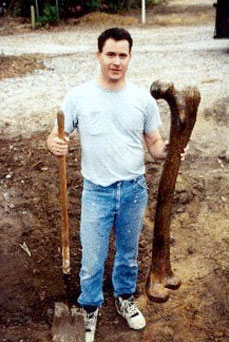We had a stormy day here in Holland, and it resulted in this gorgeous time lapse video. The music is “Raindance” from my upcoming album “Beyond”.
Category: Nature
Smithsonian admits to destruction of thousands of giant human skeletons in early 1900′s
Original article by Bob Flanagan

A US Supreme Court ruling has forced the Smithsonian institution to release classified papers dating from the early 1900′s that proves the organization was involved in a major historical cover up of evidence showing giants human remains in the tens of thousands had been uncovered all across America and were ordered to be destroyed by high level administrators to protect the mainstream chronology of human evolution at the time.
The allegations stemming from the American Institution of Alternative Archeology (AIAA) that the Smithsonian Institution had destroyed thousands of giant human remains during the early 1900′s was not taken lightly by the Smithsonian who responded by suing the organization for defamation and trying to damage the reputation of the 168-year old institution.

During the court case, new elements were brought to light as several Smithsonian whistle blowers admitted to the existence of documents that allegedly proved the destruction of tens of thousands of human skeletons reaching between 6 feet and 12 feet in height, a reality mainstream archeology can not admit to for different reasons, claims AIAA spokesman, James Churward.
«There has been a major cover up by western archaeological institutions since the early 1900′s to make us believe that America was first colonized by Asian peoples migrating through the Bering Strait 15,000 years ago, when in fact, there are hundreds of thousands of burial mounds all over America which the Natives claim were there a long time before them, and that show traces of a highly developed civilization, complex use of metal alloys and where giant human skeleton remains are frequently found but still go unreported in the media and news outlets» he explains.
Missing link found between brain, immune system – with major disease implications
UNIVERSITY OF VIRGINIA HEALTH SYSTEM
– Vessels directly connecting brain, lymphatic system exist despite decades of doctrine that they don’t
– Finding may have substantial implications for major neurological diseases
– Game-changing discovery opens new areas of research, transforms existing ones
– Major gap in understanding of the human body revealed
– ‘They’ll have to change the textbooks’
Maps of the lymphatic system: old (left) and updated to reflect UVA’s discovery.

CHARLOTTESVILLE, Va., June 1, 2015 – In a stunning discovery that overturns decades of textbook teaching, researchers at the University of Virginia School of Medicine have determined that the brain is directly connected to the immune system by vessels previously thought not to exist. That such vessels could have escaped detection when the lymphatic system has been so thoroughly mapped throughout the body is surprising on its own, but the true significance of the discovery lies in the effects it could have on the study and treatment of neurological diseases ranging from autism to Alzheimer’s disease to multiple sclerosis.
New Discovery in Human Body
Kevin Lee, PhD, chairman of the UVA Department of Neuroscience, described his reaction to the discovery by Kipnis’ lab: “The first time these guys showed me the basic result, I just said one sentence: ‘They’ll have to change the textbooks.’ There has never been a lymphatic system for the central nervous system, and it was very clear from that first singular observation – and they’ve done many studies since then to bolster the finding – that it will fundamentally change the way people look at the central nervous system’s relationship with the immune system.”
Even Kipnis was skeptical initially. “I really did not believe there are structures in the body that we are not aware of. I thought the body was mapped,” he said. “I thought that these discoveries ended somewhere around the middle of the last century. But apparently they have not.”
Read the full story here: http://www.eurekalert.org/pub_releases/2015-06/uovh-mlf052915.php
